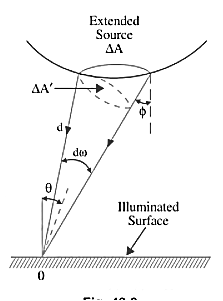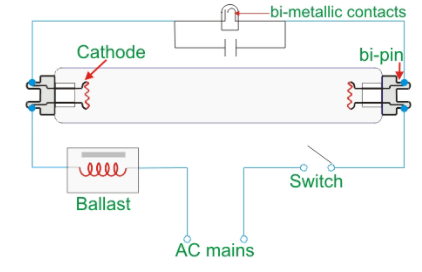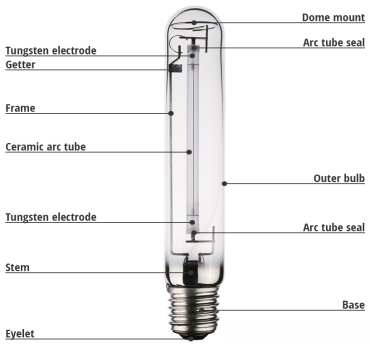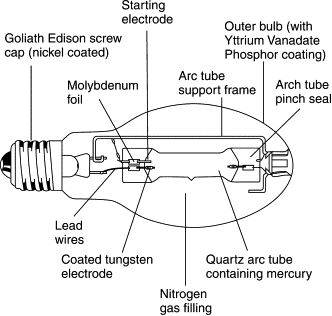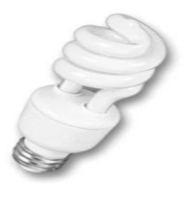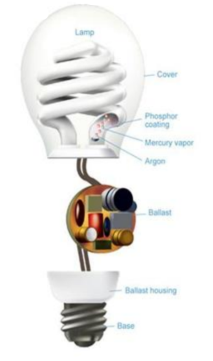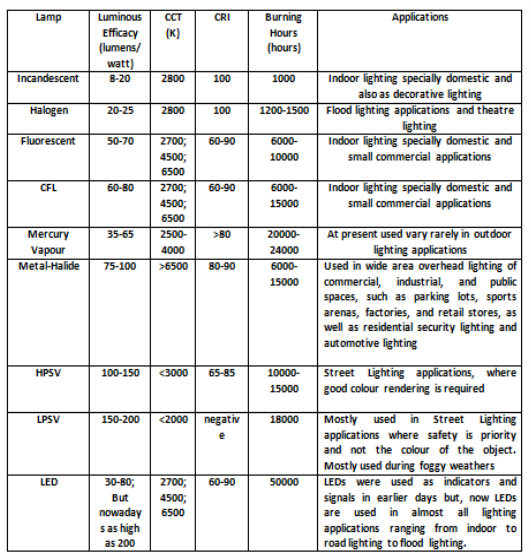Unit – 3
Utilization of Electrical Energy Tariff
The basic types of electricity tariffs used for domestic consumers are listed below
In fixed rate tariff a fixed rate is applied for each unit of energy consumed. The rate per unit of energy does not depend upon the quantity of energy used by a consumer. So, the price per unit (1kWh) of energy is constant. This energy consumed by the consumer is recorded by the energy meter.
In Flat rate tariff there are different categories of consumers and they are charged differently according to their loads and load factor. But the cost per unit of electrical energy consumed is same.
In block rate tariff first block of energy consumed is charged at a given rate and the other blocks of energy are charged at lower rates. For example, if first 30 units are charged 5 rupees than the next 10 units will be 4.5 rupees and so on.
Examples
A1) It has been given that the following devices are used as specified 3bulbs of 40W for 6hr, 4 tube-lights of 50W for 8hr and a TV of 120W for 6hr.
Total power consumed by 3 bulbs = 40x3 = 120Wh=0.12kWh
Electrical units for 1 day = 0.12x6=0.72units
Electrical units for 31 days = 0.72 x 31 = 22.32 unis
Total Power the four tube-lights consume in a day = 50x4 = 200Wh=0.2kWh
Electrical units for one day = 0.2 x 8 =1.6 units
Electrical units for 31 days= 1.6 x 31 =49.60 units
Total power the TV consumes in a day = 120x6 =720Wh=0.720kWh
Electrical units for one day = 0.720x6 = 4.32units
Electrical units for 31 days = 4.32x31=133.92units
Total units consumed = Electrical units consumed by bulb for 31 days+ Electrical units consumed by tube-light for 31 days+ Electrical units consumed by TV for 31 days
= 22.32+49.06+133.92
= 205.84units
The rate per unit is given as 2.50 per unit. So, the total bill is = 205.84x2.50 = Rs 514.60
Q2) Calculate the electricity bill amount for a month of April, if 4 bulbs of 40 W for 5 h, 4 tube-lights of 60 W for 5 h, a TV of 100 W for 6 h, a washing machine of 400 W for 3 h are used per day. The cost per unit is Rs 1.80.
A2) Electric energy consumed per day by 4 bulbs = 4x40 x5 = 800Wh
Electric energy consumed per day by 4 lights = 4x60x5 =1200 Wh
Electric energy consumed per day by TV = 100x6 = 600 Wh
Electric energy consumed per day by washing machine = 400x3 =1200 Wh
.’. Total electric energy consumed by all electric appliances = (800+ 1200 + 600+ 1200) Wh = 3800 Wh = 3.8 kWh =3.8 units
Total electric energy consumed in the month of April (30 days) = 3.8 x 30 = 114units
Cost of one unit = Rs. 1.80
Cost of 114 units = 114 x 1.80 =Rs 205.20
Electricity bill amount = Rs 205.20
Q3). A consumer has a maximum demand of 200 kW at 40% load factor. If the tariff is Rs. 100 per kW of maximum demand plus 10 paise per kWh, find the overall cost per kWh?
A3) Units consumed/year = maximum demand x load factor x hours in a year
= (200x0.4) x 8760 = 7,00,800 kWh
Annual charges = Annual M.D charge+ Annual Energy charges
= Rs(100x200+0.1x700800) = Rs. 90,080
Overall cost/kWh = Rs90080/700800 = Rs 0.1285 = 12.85 paise.
Q4). The maximum demand of a consumer is 20 A at 220 V and his total energy consumption is 8760 kWh. If the energy is charged at the rate of 20 paise per unit for 500 hours use of the maximum demand per annum plus 10 paise per unit for additional units, calculate: (i)annual bill (ii) equivalent flat rate.
A4) Let load factor and power factor be unity
Maximum demand = (220x20x1)/1000 = 4.4kW
Units consumed in 500hrs = 4.4 x 500 = 2200kWh
Charges for 2200kWh = Rs 0.2 x 2200 = Rs 440
Remaining Units = 8760-2200 = 6560kWh
Charges for 6560kWh = Rs 0.1 x 6560 =Rs 656
Total annual bill = Rs (440+656) = Rs 1096
Equivalent flat rate = 1096/8760 = Rs 0.125 = 12.5 paise
Key takeaway
1 unit of electricity means 1kWh of electricity consumption which is the unit of electrical power.
Luminous Flux
It is the light energy radiated out per second from the body in the form of luminous light waves. It is denoted by F or φ. It can also be defined as the flux contained per unit solid angle of a source of one candela.
Luminous Intensity
The luminous intensity of a point source in any particular direction is given by the luminous flux radiated out per unit solid angle in that direction. It is denoted by I.
I = If flux is measured in lumens and solid angle in steradians then total flux radiated is given by
|
Candle-Power
The luminous intensity power of a source is different in different directions. The average candle power of a source is the average value of its candle power in all directions. It is called as mean spherical candle-power (MSCP)
MSCP = The average power taken over a hemisphere is known as mean hemispherical candle power (MHSCP). It is given by the total flux emitted in a hemisphere divided by the solid angle subtended at the point source by the hemisphere. MSCP = |
Luminance
|
Fig 1 Luminance Calculation
L =
By illuminance E =
dω = E = |
Luminance Efficiency
The efficiency of a lamp is the ratio of luminous flux to the power intake. Its unit is lumen/watt.
|
Key takeaway
Luminous Intensity I = Luminance Efficiency
|
Fluorescent Lamp
|
Fig 2 Fluorescent Lamp Circuit
When the switch is turned on the lamp and the ballast have full supply voltage across them. There is glow discharge formed in the starter at full supply voltage. This also ionises the gas inside the starter and in turn heats the bimetallic strip. The bimetallic strip then bends and is connected to the fixed contact. This establishes the flow of current from the starter and when the current flows through the neon bulb of starter the voltage across the neon bulb is reduced.
The current flow is reduced near neon bulb as there is voltage drop across the ballast. There will not be any gas discharge in the neon bulb when there is no voltage across the starter of neon bulb. At the time of breaking of the contacts in the neon bulb of the starter, the current gets interrupted, and hence at that moment, a large voltage surge comes across the ballast.
V= L
|
Gas discharge process gets started and continues and hence current again gets a path to flow through the fluorescent lamp tube itself. During discharging of penning gas mixture, the resistance offered by the gas is lower than the resistance of starter. The discharge of mercury atoms produces ultraviolet radiation which in turn excites the phosphor powder coating to radiate visible light.
Starter gets inactive during glowing of fluorescent lamp because no current passes through the starter in that condition
Sodium Vapour Lamp
Low Pressure Sodium Vapour Lamp
|
Fig 3 Low Pressure Sodium Vapour Lamp
When power is supplied the lamp is energised and the electrodes produce an arc and this arc strikes through the conductive gas and lamp produces a reddish-pink light. The heat is generated due to the current flowing through argon and neon mixture and heat vaporizes the metallic sodium.
High Pressure Sodium Vapour Lamp
|
Fig 4 High Pressure Sodium Lamp
The inner arc tube is filled with xenon gas and this gas is used for starting the lamp. Sodium mercury amalgam is also present in the arc with xenon gas. Tungsten coated electrodes are mounted at each end. The outer bulb is heat resistance and consists of arc tube inside. There is vacuum between bulb and the tube which insulates heat from arc. These bulbs have smaller diameter and has no space for starting electrode. A ballast with igniter is used to initiate higher voltage required by arc.
Due to this high voltage xenon arc is formed. Amalgam used in the reservoir formed inside the arc tube. It vaporizes during the lamp operation. As the temperature in the arc starts the mercury vaporizes and with gradual increase in temperature the sodium also vaporises resulting in monochromatic yellow sodium spectrum.
Mercury Vapour Lamp
Fig 5 Mercury Vapour Lamp
It has an inner quartz arc tube and outer borosilicate glass envelope. The nitrogen gas is filled between the tubes for insulation.so that the metal can be protected from oxidation. Due to the quartz, it can withstand the temperature up to 1300K. The arc consists of two electrodes and starting electrodes. The electrodes are dipped into mixture of thorium, calcium and barium carbonates. The electrodes hold a tungsten rod upon which a double layer of coiled tungsten wire is wound.
They are heated to convert these compounds into oxides after dipping. Thus, they get thermally and chemically stable to produce electrons. The electrodes are connected through a quartz tube by molybdenum foil leads. The supply voltage when applied reaches to the starting electrode and the bottom electrode. The voltage gradient in the gap between the starting electrode and main electrode is high.
A local argon arc is created due to the high voltage gradient across the starting electrode and the bottom electrode. This initial arc heats up the mercury and vaporizes it and this mercury vapor helps to strike the main arc soon. But the resistance for the main arc current control resistor is somewhat less than the resistance of the resistor used in the initial arc current control purpose. For this reason, initial arc stops and main arc continues to operate. The mercury vapor arc gives visible spectra of green, yellow and violet. But there may be still some invisible ultraviolet radiation during discharging process of mercury vapour so phosphor coating may be provided on outer glass cover to improve efficiency of the mercury lamp.
CFL (Compact Fluorescent Lamp): They are the smaller version of common fluorescent lights which are used. The old CFLs had delay or flicker when turned on because they used magnetic ballasts. The new CFLs use magnetic ballasts. The CFLs life equivalent to 10 incandescent lamps.
|
Fig 6 CFL
Construction
The traditional fluorescent lamp tube is only used here. This tube is bent into compact size such that it gets fixed in ordinary incandescent fixtures.
|
Fig 7 Internal Circuit of CFL
It consists of a soda lime glass tube which is filled with argon and a drop of mercury. The tube end is sealed with metal electrodes, they conduct electricity from the external circuit to the gas inside tube. The main parts of CFL are gas filled tube and the electronic blast. An electrical current from the ballast flows through the mercury vapor, emitting ultraviolet light. This, ultraviolet light further excites a phosphor coating present inside the tube.
The coating is responsible for emitting visible light. They require more energy when they are turned on. It takes 30 seconds to 3minutes for the electricity to pass through the bulb and get it started. It happens so because the lamp also requires a current to preheat the filaments, a high voltage for ignition and finally a high frequency AC current for running. The electronic blast first converts AC to DC at low frequency in input and again converting DC to AC at the output on high frequency.
Advantages
- CFLs are cost efficient.
- CFLs are energy efficient, since it requires less energy to provide same amount of light.
- CFL light bulbs are long lasting and can last up to 10,000 hours.
- CFLs are very versatile and can fit into a standard light socket and do not call for any special lighting fixture.
- Dimmers are also available for some CFLs so as to control their brightness.
- CFLs comes in different colours and various shapes.
- Each CFL over its lifetime saves 450 pounds of carbon from being produced, considered to be a powerful saving.
Key takeaway
|
A well-designed lighting scheme is one which provides adequate illumination, avoids glare and hard shadows and provides sufficiently uniform distribution of light all over the working plane. Following two factors are important for lighting design:
i) Utilization factor or Coefficient of Utilization: it is the ratio of the lumens actually received by a particular surface to the total lumens emitted by a luminous source. It is an indication of the effect of the lighting equipment and the interior combined in producing horizontal illuminance. For example, UF of 0.3 means that the lumen reaching horizontal plane is 30% of the lumens of the lamp operated bare under standard conditions. The value of this factor varies widely and depends on the following factors: Type of lighting system, whether direct, indirect etc. The type and mounting height of fittings. The colour and surface of walls and ceiling. To some extent the shape and dimensions of the room.
ii) Depreciation factor/ Maintenance factor: It is the ratio of illuminance halfway through a cleaning cycle, to what the illuminance would be if the installation was clean. This factor allows for the fact that the effective candle power of all lamps or luminous sources deteriorates due to blackening and/ or accumulation of dust or dirt on the globes and reflectors etc. Similarly walls and ceilings also do not reflect as much light as when they are clean. Taking into consideration the utilization and depreciation or maintenance factors, the expression for gross lumens required is:
Total lumens =
|
Example
Solution:
Given E= 250 lm/sqm, A=30x10= 300 sq m, D.F. = 0.9, U.F. = 0.4. Total lumens = Total lumens = (250 x 300)/(0.9 x 0.4) = 208333 lm Flux emitted per lamp = 300x14= 4200 lm. ∴ Number of lamps required = 208333/4200 = 50.
|
Reference:
1) Basic Electrical Engineering, S.N. Singh, PHI, Learning Private Limited.
2) A Text Book Of Electrical Technology, B. L. Tharaja and A. K. Tharaja, S. Chand
Publication (Volume II & III)
3) Electrical Machines M. N. Bandyopadhya, PHI, Learning Private Limited.
4) Electrical Machines, Ashfaq Husain, Dhanpatrai Company, 4th edition.
5) Basic Electrical Engineering, D.C. Kulshreshtha, revised 1st edition, Tata Mc-Graw Hill education pvt. Ltd.
6) Generation of Electrical Energy- B. R. Gupta 4th Edition S Chand Publication
7) Testing Commissioning Operation & Maintenance of Electrical Equipment – S. Rao Khanna Publication








